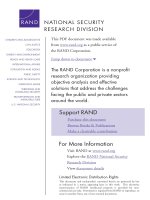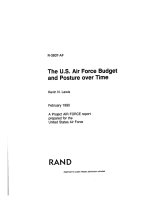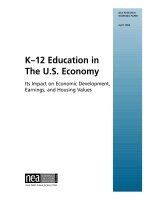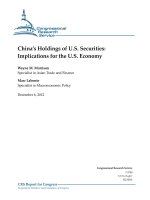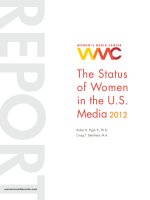Unfolding the Future of the Long War - Motivations, Prospects, and Implications for the U.S. Army docx
Bạn đang xem bản rút gọn của tài liệu. Xem và tải ngay bản đầy đủ của tài liệu tại đây (1.5 MB, 230 trang )
This document and trademark(s) contained herein are protected by law as indicated
in a notice appearing later in this work. This electronic representation of RAND
intellectual property is provided for non-commercial use only. Unauthorized
posting of RAND PDFs to a non-RAND Web site is prohibited. RAND PDFs are
protected under copyright law. Permission is required from RAND to reproduce,
or reuse in another form, any of our research documents for commercial use. For
information on reprint and linking permissions, please see RAND Permissions.
Limited Electronic Distribution Rights
Visit RAND at www.rand.org
Explore the RAND Arroyo Center
View document details
For More Information
This PDF document was made available
from www.rand.org as a public service of
the RAND Corporation.
6
Jump down to document
THE ARTS
CHILD POLICY
CIVIL JUSTICE
EDUCATION
ENERGY AND ENVIRONMENT
HEALTH AND HEALTH CARE
INTERNATIONAL AFFAIRS
NATIONAL SECURITY
POPULATION AND AGING
PUBLIC SAFETY
SCIENCE AND TECHNOLOGY
SUBSTANCE ABUSE
TERRORISM AND
HOMELAND SECURITY
TRANSPORTATION AND
INFRASTRUCTURE
WORKFORCE AND WORKPLACE
The RAND Corporation is a nonprofit
research organization providing
objective analysis and effective
solutions that address the challenges
facing the public and private sectors
around the world.
Purchase this document
Browse Books & Publications
Make a charitable contribution
Support RAND
This product is part of the RAND Corporation monograph series.
RAND monographs present major research findings that address the
challenges facing the public and private sectors. All RAND mono-
graphs undergo rigorous peer review to ensure high standards for
research quality and objectivity.
Prepared for the United States Army
Approved for public release; distribution unlimited
ARROYO CENTER
Unfolding the Future
of the Long War
Motivations, Prospects, and
Implications for the U.S. Army
Christopher G. Pernin, Brian Nichiporuk, Dale Stahl,
Justin Beck, Ricky Radaelli-Sanchez
The RAND Corporation is a nonprofit research organization providing
objective analysis and effective solutions that address the challenges
facing the public and private sectors around the world. RAND’s
publications do not necessarily reflect the opinions of its research clients
and sponsors.
R
®
is a registered trademark.
© Copyright 2008 RAND Corporation
All rights reserved. No part of this book may be reproduced in any
form by any electronic or mechanical means (including photocopying,
recording, or information storage and retrieval) without permission in
writing from RAND.
Published 2008 by the RAND Corporation
1776 Main Street, P.O. Box 2138, Santa Monica, CA 90407-2138
1200 South Hayes Street, Arlington, VA 22202-5050
4570 Fifth Avenue, Suite 600, Pittsburgh, PA 15213-2665
RAND URL:
To order RAND documents or to obtain additional information, contact
Distribution Services: Telephone: (310) 451-7002;
Fax: (310) 451-6915; Email:
The research described in this report was sponsored by the United States
Army under Contract No. W74V8H-06-C-0001.
Cover photo courtesy of AP Photo/Todd Pitman
Library of Congress Cataloging-in-Publication Data
Unfolding the future of the long war : motivations, prospects, and implications for the
U.S. Army / Christopher G. Pernin [et al.].
p. cm.
Includes bibliographical references.
ISBN 978-0-8330-4631-4 (pbk. : alk. paper)
1. United States—Military policy—Forecasting. 2. Islamic countries—Military
relations—United States—Forecasting. 3. United States—Military relations—
Islamic countries—Forecasting. 4. War on Terrorism, 2001–—Forecasting.
5. Military planning—United States. 6. United States. Army—Planning. 7. United
States—Armed Forces—Planning. I. Pernin, Christopher G., 1973–
UA23.U46 2008
355'.033573—dc22
2008050573
iii
Preface
is document explores how the “long war” might unfold in the
coming years. It looks out to about the year 2020 and reports on the
major trends, uncertainties, participants, and ways the long war might
unfold through the use of eight specific trajectories.
is work will interest those involved in military training, force
structure, policy, and how the confluence of governance, terrorism, and
ideology might affect the U.S. military forces.
is research was sponsored by the U.S. Army Training and
Doctrine Command, Army Capability Integration Center, and was
conducted within RAND Arroyo Center’s Force Development and
Technology Program. RAND Arroyo Center, part of the RAND Cor-
poration, is a federally funded research and development center spon-
sored by the United States Army.
Questions about this report should be sent to the Project Lead,
Christopher G. Pernin (). Questions concerning
RAND Arroyo Center’s Force Development and Technology Program
should be directed toward the Program Director, Bruce Held (bruce_
).
e Project Unique Identification Code (PUIC) for the project
that produced this document is DAPRR06014.
For more information on RAND Arroyo Center, contact the
Director of Operations (telephone 310-393-0411, extension 6419; FAX
310-451-6952; email ), or visit Arroyo’s web
site at />
v
Contents
Preface iii
Figures
ix
Tables
xi
Summary
xiii
Acknowledgments
xxix
Glossary
xxxi
CHAPTER ONE
Introduction 1
Focus of is Study
1
Organization of is Report
3
CHAPTER TWO
What Is the Long War? 5
Background and Use of the Term “Long War”
5
A Synthesis Description of the Long War: e Confluence of
Governance, Terrorism, and Ideology
10
Ideology in the Current Long War
16
Governance in the Current Long War
18
Terrorism in the Current Long War
19
Toward Defining the Participants
21
CHAPTER THREE
Who Is Involved in the Long War? 23
Past Definitions of the Adversary
24
A Framework for Understanding the Participants in the Long War
27
vi Unfolding the Future of the Long War
Expanding the Framework of Participants rough Influence Diagrams .33
Conclusions
39
CHAPTER FOUR
What Will Affect the Way the Long War Unfolds? 41
Trends and Drivers of the Long War
41
Uncertainties: e Variables at Drive Alternative Trajectories
43
Weapons Proliferation and Capabilities of Nonstate Actors
43
e Prevalence of Weak/Failed States as Safe Havens
47
Middle Eastern Political Stability
48
International Support for U.S. Actions
49
Domestic Support for the Long War
50
e Draw of Conventional War
53
Summary
54
CHAPTER FIVE
How Might the Long War Unfold? 57
Generating Alternative Trajectories
58
e Eight Trajectories
61
Steady State
61
War of Ideas
63
Narrowing of reat
66
Major Muslim Nation Goes Bad
69
Expanding Scope
77
Holding Action
81
Sustained Sunni-Shia Conflict
84
Chronic Insurgencies/Instability
89
CHAPTER SIX
What Does is Mean for the Army? 95
Introduction
95
Seven Strategies for the Long War
96
Shrink the Swamp
96
Inside Out
98
State-Centric
98
Contain and React (Defensive)
99
Contents vii
Ink Blot (Seize, Clear, and Hold) 99
Underlying Causes
100
Divide and Rule
101
Responses to and Implications of the Trajectories
102
Narrowing of reat
104
Steady State
105
Sustained Sunni-Shia Conflict
106
Major Muslim Nation Goes Bad
108
Expanding Scope
111
Holding Action
112
Chronic Insurgencies/Instability
114
War of Ideas
116
CHAPTER SEVEN
Observations on the Long War 117
Broad Observations
117
As Appropriate, the Military Should Define and Set Appropriate
Goals for Any Engagements Associated with the Long War in
Terms of the Confluence of Governance, Terrorism,
and Ideology
117
e Army Should Plan and Prepare to Be Involved with Aspects
from Across the GTI Construct
119
e Army Should Consider Mission Sets at Allow for a More
Proactive Effect Across the GTI Construct
120
e Enduring Missions of the Force Combined with the Evolving
Responses to the Long War Imply an Agile and Flexible
Military
121
e Military Should Consider the Vulnerability of the Assumption
at Major Combat Operations Will Be eir Most Pressing
Issue in the Medium and Longer Term
121
e Military, and More Specifically the Army, Should Plan for
Potential Involvement in Medium- to Large-Scale Stability
Operations and Nation Building
122
e Army Should Continue to Identify and Adopt Niche Capabilities
to Prosecute the Long War
123
viii Unfolding the Future of the Long War
APPENDIX
A. Short Descriptions of Ideology, Governance, and Terrorism 125
B. e Use of Civilizational Conflict When Describing
the Long War
151
C. Interpreting the Influence Diagram
157
D. Relating Long War Strategies to Grand Strategies
165
E. Location of Oil and Natural Gas Resources
171
F. Demographic Trends and Factors
175
G. Water in the Middle East
181
Bibliography
183
ix
Figures
S.1. Long War as the Confluence of Terrorism, Governance,
and Ideology
xiv
1.1. Five Main Questions Addressed in is Report
3
2.1. Long War as the Confluence of Governance, Terrorism,
and Ideology
13
3.1. Framework for Understanding Objectives and Motives for
Various Violent Nonstate Groups (Groups 1 rough 4)
28
3.2. Factors Contributing to the reat of Salafi-Jihadism:
Initial Analysis
34
3.3. Factors Contributing to the reat of Salafi-Jihadism:
Initial Analysis Expanded
36
3.4. e Current Dominant Factors and Examples of How
U.S. Actions Can Be Represented
37
3.5. Examples of Some Current Actors and reat Risks
Being Faced in the Long War
38
4.1. Influence Diagram Showing Factors Affecting the
U.S. Ability to Prosecute the Long War
50
5.1. Target Diagram for “Pakistan Goes Bad”
74
5.2. Influence Diagram for “Major Muslim Nation Goes Bad”
75
5.3. Target Diagram for the “Expanding Scope” Trajectory
Where Hezbollah Attacks the West
80
5.4. Influence Diagram Showing Factors Affecting the
U.S. Ability to Prosecute the Long War
84
5.5. Influence Diagram for the “Chronic Insurgencies/Instability”
Trajectory
92
6.1. How Elements of Strategy Can Affect the Factors in the
Long War
97
x Unfolding the Future of the Long War
B.1. Breakdown of Sunni and Shia Majorities from
Northern Africa to Indonesia
155
C.1. Influence Diagram: Stage 1
157
C.2. Influence Diagram: Stage 2
160
C.3. Influence Diagram: Nearly Complete
161
C.4. Influence Diagram: Complete
163
E.1. Proven Reserves for Natural Gas and Oil
172
E.2. Disruptions in Oil Production
173
E.3. World Oil Production Projections Shown in Millions
of Barrels per Day
174
F.1. Saudi Arabia’s Youth Bulge (Projected for 2025)
178
G.1. Per Capita Fresh Water Availability Pojections for
1995, 2025, and 2050
182
xi
Tables
S.1. Short Description of the Eight Trajectories Discussed
in is Report
xvii
1.1. Tagline Descriptions of the Eight Trajectories Discussed
in is Report
2
2.1. Breakdown of Different Interpretations of the Long War
15
2.2. Descriptions of Some Ungoverned Areas with Large
Muslim Populations
20
3.1. Examples from Groups 1 rough 4 of the Framework
30
4.1. Trends and Drivers Forming the Basis for is Report
42
4.2. Number of New Nuclear States Each Decade
44
4.3. Example Levels of Uncertainties Contained in is Report
54
5.1. Association of Particular Uncertainties Being Tested
(Columns) with the Eight Trajectories (Rows)
59
5.2. Short Descriptions of the Trajectories
60
5.3. Motives, Means, and Opportunities for the “Major Muslim
Nation Goes Bad” Trajectory
70
5.4. Motives, Means, and Opportunities for the “Expanding
Scope” Trajectory
78
5.5. Motives, Means, and Opportunities for the “Sustained
Sunni-Shia Conflict” Trajectory
86
5.6. Motives, Means, and Opportunities for the “Chronic
Insurgencies/Instability” Trajectory
91
6.1. Existence of the Seven Long War Strategies (Across the Top)
in the Eight Trajectories
103
7.1 How Certain Operations Might Manifest emselves
in the Individual Trajectories
118
xii Unfolding the Future of the Long War
B.1. Civilizational Construct for the Long War 154
D.1. Compatibility of U.S. Grand Strategies (in the Rows) and
Potential Long War Strategies (in the Columns)
169
xiii
Summary
e United States is currently engaged in what has been characterized
as the “long war.” e long war has been described by some as an epic
struggle against adversaries bent on forming a unified Islamic world to
supplant Western dominance, while others characterize it more nar-
rowly as an extension of the war on terror. But while policymakers,
military leaders, and scholars have offered numerous definitions of the
long war, no consensus has been reached about this term or its implica-
tions for the United States. To understand the effects that this long war
will have on the U.S. Army and on U.S. forces in general, it is necessary
to understand more precisely what the long war is and how it might
unfold. To address this need, this study explores the concept of the
long war and identifies potential ways in which it might unfold as well
as the implications for the Army and the U.S. military more generally.
Framework for Understanding the Long War
As seen in Figure S.1, one way to think about the potential threats the
United States faces in the long war is to consider the confluence of three
problems raised by the war: those related to the ideologies espoused by
key adversaries in the conflict, those related to the use of terrorism, and
those related to governance (i.e., its absence or presence, its quality, and
the predisposition of specific governing bodies to the United States and
its interests). e goal of this report is not to determine which of these
areas is the key problem. Instead, we take the stance that to ensure that
this long war follows a favorable course, the United States will need to
make a concerted effort across all three domains.
xiv Unfolding the Future of the Long War
Figure S.1
Long War as the Confluence of Terrorism,
Governance, and Ideology
RAND MG738-S.1
Governance
Ideology Terrorism
Long
war
Also important for understanding the long war is a definition of
the adversary. Because several of the adversaries that have attacked the
United States have espoused an ideology laced with Islamic motifs and
juridical justifications, this study examined groups operating within
predominantly Muslim countries and organized them into categories
based on an understanding of their motivating ideas and goals:
1
Doctrinaire jihadists, whether global in orientation or internally t
focused, who adhere to a version of Islam known as Salafi-jihadism.
is interpretation of Islam rejects modernism and emphasizes
the concepts of jihad (holy struggle) and takfir (declaring another
Muslim an infidel).
Religious nationalist organizations such as Hezbollah and HAMAS t
that participate in the political process but that are also willing to
1
For the purposes of this report, we use the term “Muslim world” to denote those states
with predominantly or large Muslim populations. Many of these states are located in the
Middle East and northern Africa, and others span south and southeast Asia through to
Indonesia.
Summary xv
use violence, sometimes against their own people, to dominate a
particular community, region, or nation.
Other groups whose primary motivation is secular, such as com-t
munists, Arab nationalists, or Ba’athists.
In addition to these groups, other nonviolent organizations operating
within predominantly Muslim nations can sometimes provide a “gate-
way” for entrance into more radical organizations.
is categorization scheme helps illustrate the diversity of groups
plausibly involved in a long war with the United States and indicates
the assortment of economic, social, and political factors and griev-
ances that can motivate adversaries. Some groups in this scheme pose a
greater or lesser relative threat than do others (e.g., doctrinaire jihadists
with an external focus constitute the greatest threat) and thus require
the United States to have a range of approaches available to deal with
them.
Alternative Trajectories
e study identified eight alternative “trajectories,” or paths, that the
long war might take. e trajectories emphasize not what the future
looks like, but the ways in which it might unfold. e eight trajectories
discussed in this report are listed and briefly defined in Table S.1.
Strategies for Addressing the Trajectories
In addressing the future of the long war, we identified a number of
trends and uncertainties associated with the future combat environ-
ment. is analysis, combined with our understanding of the com-
ponents of the long war, provided the basis for a set of seven strategy
options for the United States in the long war.
xvi Unfolding the Future of the Long War
Divide and Rule
Divide and Rule focuses on exploiting fault lines between the various
Salafi-jihadist groups to turn them against each other and dissipate their
energy on internal conflicts. is strategy relies heavily on covert action,
information operations (IO), unconventional warfare, and support
to indigenous security forces. Divide and Rule would be the obvious
strategy choice for the “Narrowing of reat” trajectory as the United
States and its local allies could use the nationalist jihadists to launch
proxy IO campaigns to discredit the transnational jihadists in the eyes
of the local populace. In the “Holding Action” trajectory, Divide and
Rule would be an inexpensive way of buying time for the United States
and its allies until the United States can return its full attention to the
long war. U.S. leaders could also choose to capitalize on the “Sustained
Shia-Sunni Conflict” trajectory by taking the side of the conservative
Sunni regimes against Shiite empowerment movements in the Muslim
world.
Shrink the Swamp
Shrink the Swamp tries to slowly reduce the space in the Muslim world in
which Salafi-jihadist groups can operate. It is an “outside-in” approach
that seeks to stabilize the outer geographic edges of the Muslim world
to the point where those countries are inoculated against Salafi-jihadist
ideology. is strategy is particularly germane to the “Narrowing of
reat” trajectory. After isolating the transnational jihadists from the
rest of the jihadist movement, the United States could work to eradi-
cate the transnational jihadist presence from the outer geographic rings
of the Muslim world—i.e., Indonesia, Malaysia, and Morocco—by
working intensively with local security forces to eliminate the fund-
ing, educational, and recruitment mechanisms that support al-Qaeda
and its affiliates in those countries. e strategy might also apply to the
“Steady State” and “Sustained Sunni-Shia Conflict” trajectories.
Inside Out
is strategy holds that the United States should use decisive conventional
military force to change the regime in certain key Muslim countries and
impose democracy in its place. e theory here is that the geopolitical
Summary xvii
Table S.1
Short Description of the Eight Trajectories Discussed in This Report
1 Steady State Baseline case largely reminiscent of current actions and
environment. In this vision, the threat continues to be the broad
universe of radical Salafi-jihadists, including both transnational
and sometimes regional groups.
2 War of Ideas Shift to information-based campaign with the goal of isolating
jihadists and their infrastructure from the broader global Muslim
population. Plans to confront Iran militarily over its nuclear
program are shelved for the time being.
3Major
Muslim
Nation Goes
Bad
Radical shift in a regime brought on when a critical state in the
Muslim world is taken over by radical extremists. Two of the
most plausible and most threatening scenarios to American
interests would be a military coup in Pakistan or a successful
fundamentalist insurgency in Saudi Arabia.
4 Narrowing
of Threat
Conflict arising between jihadists leads the U.S. to take a “divide
and conquer” approach in order to exploit cleavages among
transnational jihadists and local/regional jihadists. Consequently,
the U.S. would adopt a more flexible position toward local
and nationalist Islamist groups like HAMAS and Moro Islamic
Liberation Front (MILF) in the Philippines.
5 Expanding
Scope
Expanded scope of the long war threat beyond a major terrorist
attack against U.S. interests to include radical Shiism, the Iranian
state, regional terrorists, and/or some non-Islamic terror groups.
In this formulation, the long war would become a true global
war on terror.
6Holding
Action
A series of geopolitical shocks (e.g., an attempt by China to shift
the balance of power in the Western Pacific or a sudden, violent
implosion of North Korea) would compel the U.S. to temporarily
scale back its efforts against Salafi-jihadists in order to focus
on more traditional threats that require a response involving
conventional forces and diplomatic capital.
7Sustained
Sunni-Shia
Conflict
Widespread violence between Shia and Sunni groups, resulting
in deep fault lines between Shia and Sunni communities
throughout the Muslim world. As a result, the U.S. is led to
concentrate, in the short term, on shoring up the traditional
Sunni regimes in Saudi Arabia, Egypt, and Pakistan as a way of
containing Iranian power and influence in the Middle East and
Persian Gulf.
8 Chronic
Insurgencies/
Instability
Serious insurgencies and unrest around the world that drain
the resources of the U.S. and its allies and decrease regime
legitimacy. The insurgencies are driven largely by dissatisfaction
with inefficient and ineffective governmental structures,
dilapidated infrastructure in terms of basic services, and
questions of legitimacy of the current leaders.
earthquake caused by regime change will empower democratic forces
throughout the Muslim world and force much of the Salafi-jihadist war-
rior community to come out into the open to fight U.S. conventional
xviii Unfolding the Future of the Long War
forces, thus giving the United States a better chance of crushing them
decisively. is strategy is part of the “Steady State” because of the con-
tinuing focus on building democracy at some level in Afghanistan and
Iraq. Although the notion that the birth of democracy in those two
countries would cause it to spread throughout the entire Middle East
has long since been discredited, one can still argue that the existence of
two democratic states in the middle of the Muslim world would create
two likely security partners and potential allies for the United States
over the long term. In the “Sustained Sunni-Shia Conflict” trajectory,
the United States might take an aggressive stance by seeking to over-
throw the Iranian regime and replacing it with a moderate one that
does not rely on Shiite chauvinism for its legitimacy.
State-Centric
State-Centric aims to spread effective governance throughout the Muslim
world by strengthening established regimes, giving them more resources,
and making them less brittle. e theory here is that the main driver
behind the Salafi-jihadist surge is the existence of ungoverned spaces
(like the tribal areas of Pakistan) and public administrations that
cannot deliver basic services to ordinary people. e State-Centric
strategy applies across all eight trajectories. For example, in the “Steady
State” trajectory, the United States would continue to bolster exist-
ing regimes against insurgencies, terrorism, and social instability while
nudging them toward improvements in the provision of basic services
to the population. In the “Sustained Sunni-Shia Conflict” trajectory,
the United States would work to build the institutional capacities of at-
risk Muslim states so that their security forces could contain sectarian
violence effectively. In the “Chronic Insurgencies/Instability” trajec-
tory, State-Centric would be useful in countries that have stabilized
their domestic security situation to the point where the insurgents are
not gaining territory or influence.
Contain and React
Contain and React is a fundamentally defensive strategy that seeks to hold
a “perimeter” in the Muslim world and only act strongly if that perimeter
is breached (i.e., a U.S. ally is threatened with collapse or overthrow).
Summary xix
As a predominantly defensive strategy, the threshold for U.S. involve-
ment would be high and would be contingent on a good relationship
between the United States and its ally in the region. At the point of
intervention, the United States would react with general purpose forces
from a geographic perimeter location. is contrasts with other strate-
gies such as Inside Out, where proactive U.S. actions would entail more
aggressive actions across a broader group of states in the region.
is strategy has applications for several trajectories. For example,
in “Major Muslim Nation Goes Bad,” Contain and React would seek
to position U.S. military forces in neighboring states to deter the newly
radicalized state from threatening its neighbors. In “Expanding Scope,”
this strategy could be used to try to fence off groups like Hezbollah in
finite swaths of territory with stepped-up border enforcement as well as
periodic strikes and raids. Contain and React would be the preferred
choice for the “War of Ideas” because the ideational campaign would
be an ideal, low-cost, low-visibility tool for containing al-Qaeda and
Salafi-jihadist ideologues.
Ink Blot (Seize, Clear, and Hold)
Ink Blot is a global counterinsurgency (COIN) strategy that aims to seize,
clear, and hold strategically important areas throughout the Muslim
world by working actively with local security forces. Under this strat-
egy, the United States would work with key allies like Algeria, Egypt,
and Yemen to remove all Salafi-jihadist elements from certain areas
through a classic COIN approach that concludes with infrastructure
restoration and the formation of local self-defense militias. e hope
here would be that over time the Salafi-jihadist groups would be rel-
egated to the geographic margins of the Muslim world and cut off from
one another. In the “Chronic Insurgencies/Instability” trajectory, Ink
Blot would be reserved for those insurgencies and areas of instability in
which the insurgents are gaining ground and influence. e approach
might also be applicable to the “Steady State” and “Narrowing of the
reat” trajectories.
xx Unfolding the Future of the Long War
Underlying Causes
Underlying Causes holds that the United States needs to attack the broad
underlying socioeconomic problems of the Muslim world on a regional,
rather than country-specific, basis. e United States would work steadily
to deal with the demographic, resource scarcity, labor market, and
public health problems that create poor living conditions and social
frustration in the Middle East, South Asia, and North Africa. Over
time, the theory is that better basic socioeconomic conditions would
reduce the appeal of radical Salafi-jihadist ideas and create support for
free market openness. is strategy would entail only a small role for
the U.S. military. Under the “Holding Action” trajectory, the United
States might adopt a longer-term and less aggressive stance in the
Middle East. Nonmilitary organizations such as the U.S. Agency for
International Development, the State Department, the Peace Corps,
the Department of Agriculture, and the Department of Justice would
become the focus of the new U.S. strategy.
Implications for the U.S. Army
We now describe some implications for the Army arising from the
trajectories.
Steady State
In the “Steady State” trajectory, the role of the Army would be domi-
nated by any continuing commitment to Afghanistan and Iraq. e
Army is unlikely to be stretched in this scenario unless the Afghanistan
or Iraq deployments continue to be large. If the United States chooses
to engage in more peacekeeping and enforcement roles to prevent the
growth of Salafi-jihadism, the Army would require some different skill
sets from those needed in major combat, and some specialized equip-
ment might also be useful (e.g., nonlethal weapons). If the United
States decides to provide support to governments in an attempt to
reduce the number of insurgencies and instability in particular coun-
tries, such operations could involve large numbers of troops but not
nearly as many as Iraq. e continued use of Army special operations
Summary xxi
forces (SOF) for global operations against al-Qaeda could compel an
increase in SOF force structure beyond that currently programmed.
War of Ideas
ere would be two implications for the Army here. First, the Army
would need to improve all facets of its IO capabilities, including target
audience analysis, message creation, and message delivery. e Army
would also need to learn how to synchronize strategic and tactical IO
lines of operation. Second, to make tangible progress in the “War of
Ideas,” the Army would need to do its best to reduce collateral damage
during kinetic operations. is implies the need for better systems for
all-source intelligence fusion as well as weaponry to support the dis-
criminatory nature of the IO campaigns and reduce unwanted collat-
eral damage.
Major Muslim Nation Goes Bad
If the United States were to decide on a strategy of containment, then
intelligence, surveillance, and reconnaissance (ISR) as well as human
intelligence (HUMINT) assets would be required to detect and moni-
tor the flow of weapons/WMD components and people across the
border of the “bad nation.” Since it is unlikely that the United States
would commit to long-term border patrols, these ultimately would
need to be handled by the forces of the neighboring nations, and the
Army might be required to take on training or monitoring roles.
At least three proactive strategy components can be envisioned,
including the need for strike capabilities against WMD facilities to
prevent them from falling into the hands of the incoming government
(which would not involve the Army heavily) as well as SOF, seize-and-
hold, or stabilization operations, which could require a larger Army
role.
If the United States were to become directly involved in a counter-
coup, Army units might be required to train the friendly forces or
serve as advisers. A more direct confrontation between U.S. forces and
the new governments might be seen as similar to the “regime change”
operation in Iraq. Lessons from this operation are well known and
will not be repeated here. A radicalized state without weapons of mass
xxii Unfolding the Future of the Long War
destruction or effect (WMD/E) capabilities could require a less imme-
diate response from U.S. forces, such as the stationing of a couple of
U.S. Army brigades in neighboring or regional countries as a deterrent
to aggressive moves. e Army might also expect to be involved in sig-
nificant IO operations in neighboring states to help contain the fallout
and reduce the influence of Salafi-jihadist propaganda.
Narrowing of Threat
Because of the nature of the nationalist terrorist groups, any assistance
would be mainly covert and would imply advanced IO capabilities so
that it could aid other government agencies and host nations in the
effort to promote cleavages within the jihadist movement. Much of this
work would not necessarily be done by the Army. However, a narrow-
ing of the threat could also allow the U.S. forces to focus their efforts
more broadly on COIN campaigns currently being bolstered by trans-
national terrorists. In these cases, the military, and the Army in par-
ticular, could see an expanded role for COIN to target the more subtle
places those groups are providing aid.
Expanding Scope
It is likely, assuming that commitments in Iraq and Afghanistan have
been reduced, that the U.S. Army would not be stretched by the addi-
tion of another long war enemy. However, if there is still a significant
deployment in Iraq or Afghanistan, opening up a war on an additional
front may stretch the Army in terms of personnel. One of the more
significant capability needs would be for HUMINT capabilities able
to penetrate the new non-Salafi-jihadist targets, although such capa-
bilities are likely to be developed in conjunction with the intelligence
community rather than solely in the Army. It would also be useful for
the Army to accelerate its research on counter-rocket, artillery, mortar
(CRAM) technologies.
Holding Action
In this trajectory, the United States faces a conventional foe, or other
threat, that forces it to reduce its focus on the long war. e implica-
tions for the Army of this other threat are not discussed here. In regard
Summary xxiii
to the long war, the Army might revert to a training and advisory role in
countries where it might prefer to have an active presence. It is unlikely
that in the face of this new threat the United States will continue to
have “boots on the ground” where they are not desperately needed,
but if ground troops do remain fighting the long war, then they will
have to make do with fewer resources and less equipment. Addition-
ally, there might be an increased need to operate with allies who might
be required to aid the United States in offsetting the diminished U.S.
commitment in foreign internal defense (FID) and counterterrorism
missions. Depending on the nature of the conventional conflict, this
trajectory could be extremely stressful on the Army, but it would not
be the long war causing this stress.
Sustained Sunni-Shia Conflict
If the United States attempts to exploit the conflict to avoid having to
confront a united Islamic world (possibly a very unwise strategy), then
there will be little role for the Army. e exception would be the FID
missions to train host nation security forces with the possible insertion
of advisers, but this might be handled by other agencies. e United
States may also seek to end the conflict through peacekeeping opera-
tions. Here there would be a substantial role for the Army.
A third option would be to take sides in the conflict, possibly sup-
porting authoritative Sunni governments against a continuingly hostile
Iran. e level of U.S. involvement would dictate the type of opera-
tions requirement by the Army, which might, at the higher end, require
the Army to provide troop lift, logistical support, and other types of
aid, or direct involvement in the conflict, which may look partly like
an insurgency and partly like conventional war. At the latter level, the
U.S. Army would call upon rapid precision strike systems and would
have to balance aggressive operations with an IO campaign.
Chronic Insurgencies/Instability
If the United States chooses to get involved in a large number of the
insurgencies, then the Army could find itself stretched in terms of num-
bers of specialty capabilities such as Special Forces (SF), Civil Affairs
(CA), and psychological operations (PSYOPS). As the numbers grow,



